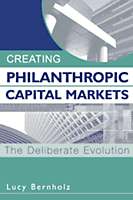I went to see
Kinsey yesterday. With all the hullabaloo about Liam Neeson's and Laura Linney's performances, the movie reviews missed at least three key points about this film. It may be the first Hollywood hit to feature a philanthropic foundation (Rockefeller). It is one of the few to use a congressional committee as part of a key plot twist (the Reece Commission, also known as The House Committee to Investigate Tax-Exempt Foundations, 1954). And the movie demonstrates that, when we talk about the impact of philanthropy, we need to extend our time horizon from 3 to 30 or 50 years.
Given the enormous sigh of relief that organized philanthropy breathed last week upon the end of the 108th Congress, now is a good time to think about what history has to teach us regarding philanthropy, risk taking, public opinion and public oversight.
Philanthropy provides private resources a role in public life. It can be used to advance democratically-supported decisions about public resources, as it often does in complementing health, family support, or educational programs. It also provides avenues for the pursuit of minority or alternative views, as it often has done in the arts, scientific research, exploration, and, yes, health, family support and educational programs.
Unfortunately, the balance between minority and majority opinion are not always in the forefront of public oversight or private action. Nor are we culturally predisposed to bring a long-term sensitivity or a historical understanding to how these balances shift over time.
It is much more likely that the catalysts to public interest in nonprofit action will be driven by immediate crises or opportunities. For example, the need for public revenue has definitely increased attention to exempt resources. At the state and municipal level, the assumption that large landholdings and enormous real property holdings will never contribute tax revenue to local communities is a constant source of "town/gown" or "town/church" frictions.
Of course, rational issues like public and private resources are not always the real cause of overseer's interest in philanthropy. In the throes of the McCarthy era, the Reece Committee's chair himself stated, "The Congress has been asked to investigate the financial backers of the institute that turned out the Kinsey sex report last August." ( Pomeroy, Wardell.
Dr. Kinsey and the Institute for Sex Research. NY: Harper & Row, 1972, p. 375).
The interest in foundations writ large stemmed from moral outrage at the sex research of Alfred Kinsey and - following the money - to the foundation that supported him. Political and moral disagreements would reappear in Congressional interest in foundation support of voter drives a decade later and in funding for human rights in Palestine four decades later. The most recent presidential election brought this opportunistic attention behavior to a new level, as charges of anti-Americanism leveled against Teresa Heinz Kerry drew from politically-motivated "analysis" of the family foundation she heads.
This is not to say that investigations of philanthropy are only catalyzed by political differences or moral outrage. There are other reasons that regulators have turned (and should continue to turn) their attention to the nonprofit sector. Abuse of tax exempt status to cover up financial shenanigans, for example. Violation of the public trust. Tax fraud and self-enrichment. These actions should draw attention to a sector that fundamentally rests on the public trust.
Ideally, we would proudly support ongoing calibrating that protect both the public good and private rights. Finding the balance between them is tricky in the best of times. In times of great political division or on issues of morality (what issues are not?) or in times of great power inequities, such balancing acts require ongoing feats of circus-level acrobatics.
Of course, one key component of maintaining your balance on the high wire is to keep your attention on a fixed point in front of you. Successful acrobats don't look at their feet - they keep their attention out in front. As we navigate the high-wire balancing act of public and private rights in the here and now, we should remember to look up and ahead. Keeping our eyes on the horizon keeps our balance intact as we take small steps forward. History has taught us this - and
Kinsey brings it the big screen: We need to take a long-term view when we act, both philanthropically and in public life. Change takes time and time brings changes.
For more on the accuracy of the movie, see the history of the
Kinsey Institute. For alternative views of the movie, Google "Kinsey Rockefeller" and you'll find plenty of voices blaming the Foundation and the scientists for what they see as today's moral failures.




